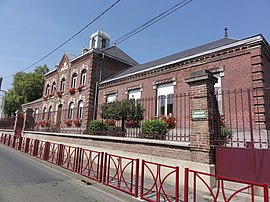Estrées, Aisne
You can help expand this article with text translated from the corresponding article in French. (December 2008) Click [show] for important translation instructions.
|
Estrées | |
|---|---|
 The town hall of Estrées | |
| Coordinates: 49°58′07″N 3°17′20″E / 49.9686°N 3.2889°E | |
| Country | France |
| Region | Hauts-de-France |
| Department | Aisne |
| Arrondissement | Saint-Quentin |
| Canton | Bohain-en-Vermandois |
| Intercommunality | Pays du Vermandois |
| Government | |
| • Mayor (2020–2026) | Jean Charles De Wever[1] |
Area 1 | 7.04 km2 (2.72 sq mi) |
| Population (2022)[2] | 408 |
| • Density | 58/km2 (150/sq mi) |
| Time zone | UTC+01:00 (CET) |
| • Summer (DST) | UTC+02:00 (CEST) |
| INSEE/Postal code | 02291 /02420 |
| Elevation | 97–149 m (318–489 ft) (avg. 136 m or 446 ft) |
| 1 French Land Register data, which excludes lakes, ponds, glaciers > 1 km2 (0.386 sq mi or 247 acres) and river estuaries. | |
Estrées is a commune in the Aisne department in Hauts-de-France in northern France.
In the Picard dialect, it is called Etré. It is one of many villages in the north of France bearing the name Estrées. The etymology of the name is from strata (cognate of English "street"), the word for the stone-layered Roman roads in the area (some of which turned into modern highways). Hence Estreti, village on the road which developed into Estrées.
Also known in ancient times as Strata or Estreti, history mentions an abbey in the 12th century. A parish was created there about 1189 with a priest sent from the abbey of Mont Saint Martin to buy land and help the poor. In 1777 Pierre Nicolas Leroy began manufacturing silk gauze here. Inhabitants are called Estrésiens.
Administration
[edit]| Term | Name |
|---|---|
| 2001–2008 | Jean-Marie Courtois |
| 2008–2020 | Gérard Lempereur |
| 2020–incumbent | Jean Charles De Wever |
Population
[edit]| Year | Pop. | ±% |
|---|---|---|
| 1962 | 424 | — |
| 1968 | 474 | +11.8% |
| 1975 | 401 | −15.4% |
| 1982 | 423 | +5.5% |
| 1990 | 434 | +2.6% |
| 1999 | 446 | +2.8% |
| 2008 | 407 | −8.7% |
See also
[edit]References
[edit]- ^ "Répertoire national des élus: les maires" (in French). data.gouv.fr, Plateforme ouverte des données publiques françaises. 13 September 2022.
- ^ "Populations de référence 2022" (in French). The National Institute of Statistics and Economic Studies. 19 December 2024.
Lua error in Module:Navbox at line 535: attempt to get length of local 'arg' (a number value).



